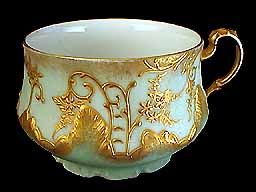
cup with raised paste work and Roman gold
(manufacturer unknown)
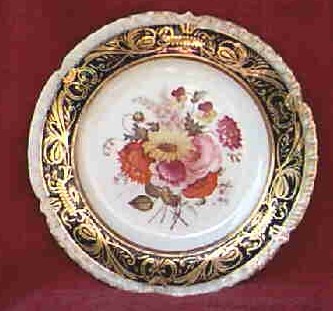
Coalport plate with raised Roman gold border
over cobalt rim
GOLD: ITS USE AND APPLICATION |

cup with raised paste work and Roman gold |

Coalport plate with raised Roman gold border |
How to mix and apply goldThere are basically four types of gold application in
general use by china painters:
|
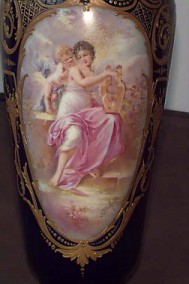
Sevres vase detail showing Roman gold scrollwork |
(1) Liquid Bright Gold(2)Liquid Burnish Gold (3) Roman Gold (fluxed ) (4) Roman Gold (unfluxed)
|
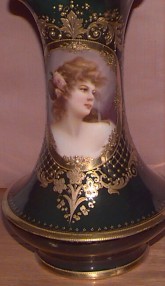
Royal Vienna vase detail with raised Roman gold work |
|
|
|
In addition to the four common use golds, there are other golds available to the china painter: White Gold, Red Gold, Green Gold and Red Bronze. Other metallics include Liquid Bright Platinum, Liquid Bright Silver and Liquid Bright Palladium. There is also a Liquid Bright Gold made for microwave ovens...(that is, NOT to be FIRED in a microwave, but to be used on pieces that will be used in the microwave, like coffee mugs) |
1. Liquid Bright Gold (LB Gold) |
|
Due to its chemical make up, this metallic luster can be damaged by contamination with turpentine and many oils, causing it to become black, gray, purple or "splotchy." Use only pure natural Lavender oil or Essence for gold to thin it and to wash the brushes used with LB Gold. After cleaning with Lavender oil , the brush can be washed with denatured alcohol if you want to remove the oil.When working with any of the metallics, cleanliness is not only next to Godliness, it is essential to "goldness". LB Gold is available in various strengths or percentages of gold content. The higher percent of gold content results in greater density of the bright metallic layer. Usually a 22% or higher gold content will cover nicely with one coat, although a heavy application of 11% is reported to cover equally well. Otherwise, most painters recommend two coats of LB Gold, firing between applications.
There is disagreement about whether LB gold needs to be shaken or stirred before use. LB gold is a luster and does not settle out the way liquid burnish gold settles. However, most painters stir or shake LB gold just to be on the safe side. Sometimes, sediment forms in the LB gold bottle and these particles can mar the gold when fired.Therefore, be cautious when shaking LB Gold.
The solvent in LB Gold evaporates fairly rapidly and when it thickens, requires addition of small amounts of Lavender oil or Essence. The liquid should be just thin enough to flow easily from the brush or pen. If too thin, the gold may run and will not result in uniform coverage. Allow the liquid gold to evaporate until the proper thickness (viscosity) is obtained. Use care to cover the area completely, avoiding any gaps in coverage. The application does not have to be totally smooth since brush marks will not show after firing. LB Gold is often applied and fired as a base for unfluxed Roman Gold.
Prior to applying any type of gold, the porcelain surface must be thoroughly cleaned to remove any trace of oils, wax, finger prints or dirt. Denatured alcohol is recommended as the cleaner of choice, although many wash the china item in a hot solution of water and dishwasher soap and rinse well prior to application.
Although many painters do not wait for the LB Gold to dry before firing it , drying is recommended. You risk the gold crazing if it is heavy and not dry before firing. It is also important to vent the kiln well while firing gold. |
2. Liquid Burnish Gold |
|
Liquid Burnish Gold is similar to LB Gold except it requires burnishing after firing and has an appearance similar to Roman Gold. Liquid Burnish Gold requires more frequent mixing by shaking or stirring during use. The gold particles tend to settle out rapidly. Burnish Gold is applied in the same way as LB Gold and has the same cautions about its solvent and application. The liquid Burnish gold is easier than Roman Gold for painting fine lines, scrolls and pen work. Most accomplished painters recommend pouring a few drops onto a glass slab or tile that has been scrupulously cleaned with alcohol. When the small quantity is used up, add another drop or two after shaking the bottle to remix the gold. If the liquid becomes too thick on the glass slab, add a small drop of essence or lavender oil. |
3. Roman Gold |
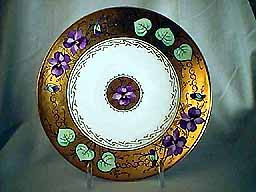
Stouffer plate with Roman gold |
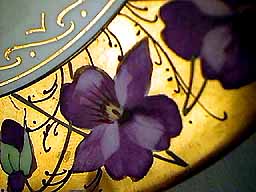
detail of Stouffer plate |
|
Roman Gold is supplied in two ways: (1) as a thin pat of hard dark brown paste on a small glass slab, or (2) as a soft paste in small jars. Both forms of Roman Gold are available as fluxed or unfluxed. If it doesn't say unfluxed on the label, it is fluxed. The unfluxed variety cannot normally be used successfully as a direct application to an unprepared china glaze since it has no flux to bind it to the surface. It can, however, be used on a soft glaze surface such as Belleek, Bone China and Faience, fired to cone 018 or 017. If Belleek is fired too hot, the glaze will shift slightly, resulting in slight ridges or a rippling effect on the fired gold. This effect is irreversible. Otherwise, unfluxed Roman Gold needs a surface prepared with a flux to prevent it being rubbed off when burnished. Fired coats of Liquid Bright Gold or a layer of china paint can serve as a receptive surface for unfluxed gold. Fluxed Roman Gold does not require a prepared fluxed surface and can be applied directly to the fresh china surface. The Roman Gold paste on a glass slab, is mixed with a solvent to soften the paste and make it thin enough to apply. There is considerable controversy about the proper solvent. Everyone agrees that Gold Facilitator works well. Many others use turpentine, lavender oil, acetone, or nitro benzine to soften the Roman Gold. The painter is cautioned to mix only enough gold for the task at hand, leaving the rest of the pat untouched. If the gold is re mixed often, it becomes diluted with solvent and medium, resulting in a lower percent of gold being applied. After softening, the paste is mixed with a spatula, using either Facilitator or Lavender oil as the medium. The paste should be mixed by lifting and turning the paste to assure even distribution of gold throughout the paste. It is noted that many authorities warn against using metal spatulas because any small particle of iron will spoil the gold when fired. They recommend either a horn, nylon or plastic spatula for mixing gold. Many of us have used a stainless steel spatula and have never had a problem. However, be warned, any corrosion on the metal could spell disaster. Gentle warming of the gold makes mixing easier. Repeated warming or getting the gold paste too hot can result in hardening the paste to a point where it is extremely difficult to soften again. After meticulous cleaning of the china surface, the gold is painted on the surface as smoothly as possible, being careful to assure complete coverage. Again, brush strokes will not show after firing. Many painters recommend warming the china before painting on the gold. The warm surface makes a smooth application easier, and assures a better bond with the glaze. Some individuals have reported that using fluxed Roman Gold over highly fluxed areas such as those covered with several layers of china paint, can cause the gold to have a dull uninteresting appearance. They recommend always using unfluxed gold over painted areas. After firing the Roman Gold, use great care when removing it from the kiln. Handle the piece with gloves or use tissue paper or a clean cloth. It is important that the gold surface not be touched with bare hands because it will discolor the gold. The piece may be burnished while still warm from the kiln or re-warmed slightly if it has cooled. Burnishing is more successful when the china piece is warm. There are several approaches to burnishing the gold. The oldest, and perhaps most common, method is to use a fine burnishing sand. Pour a small amount of sand into a small dish. Use a soft cotton cloth moistened with water and touch it to the sand. Gently polish the gold surface with the moist sand, using a circular motion, using more sand as you work. For those small, hard to reach areas, use a moist cotton swab touched to the sand, and burnish the surface.
Do not scrub hard or you may remove much of the gold. When all the surfaces have been polished to a lustrous sheen, wash away the sand and dry the piece. Any particles of the sand left on the piece and re-fired, can leave a disfiguring mark. Other burnishing techniques include:
|
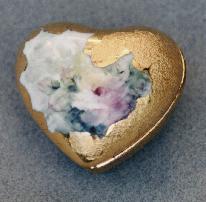
gold etched box with liquid bright gold |
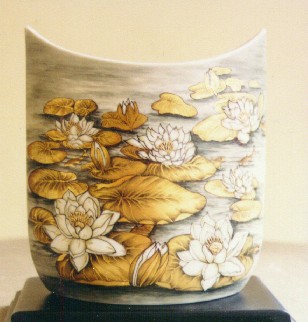
waterlily vase by Jane Yacub
|
|
|
| Home/Mailing List/Membership/Charter Members-Sponsors/China Shows/China Studios/Antiquities Gallery/Library/Web Pages/Our Favorite Links |